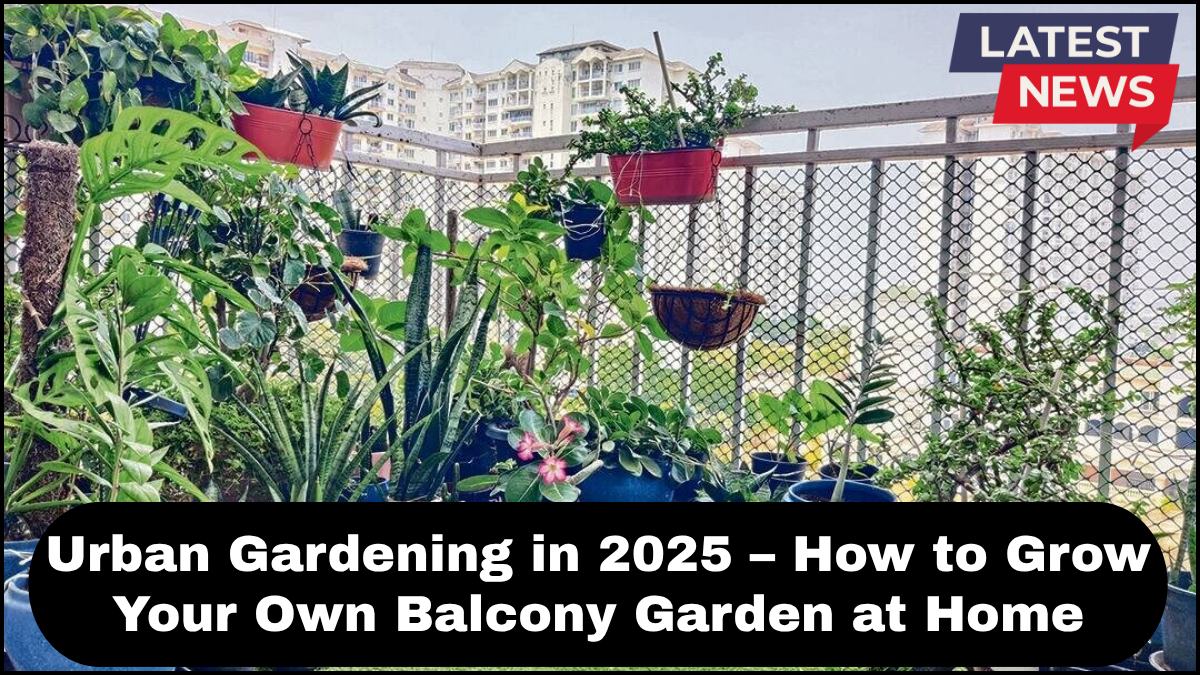Urban spaces are shrinking, but the human need to connect with nature isn’t going anywhere. In 2025, Urban Gardening at Home has become more than a hobby—it’s a movement. Whether you’re in a high-rise apartment or a modest city condo, creating a thriving balcony garden is now easier, smarter, and more rewarding than ever.

Why Urban Gardening Matters in 2025
With environmental awareness at an all-time high, more people are turning balconies into productive, green spaces. This isn’t just about aesthetics. Homegrown vegetables, herbs, and flowers contribute to sustainability, reduce grocery bills, and support mental well-being.
Thanks to new technologies and innovations, anyone can participate in Urban Gardening at Home regardless of space or experience level.
Planning Your Balcony Garden
Before you start planting, take a moment to assess your space:
- Sunlight Exposure: Track how many hours of direct sunlight your balcony gets daily.
- Weight Limitations: Some balconies can’t support large containers or water-heavy soil.
- Wind and Rain Protection: Use screens or transparent panels if your area is prone to strong winds or heavy rain.
Planning also includes setting your gardening goals. Are you aiming to grow food, flowers, or a mix of both?
Essential Tools and Materials
You don’t need a backyard to grow like a pro. Here’s what you’ll need:
- Planters: Choose vertical planters, railing boxes, or stackable pots to save space.
- Soil Mix: Use a high-quality, lightweight potting mix with good drainage.
- Self-watering Systems: These reduce maintenance and ensure consistent hydration.
- Composters: Compact worm bins or bokashi buckets help turn kitchen scraps into nutrient-rich soil.
Smart gardening kits are now available with integrated sensors to monitor soil health, moisture, and light—ideal for tech-savvy urbanites.
Top Plants for Balcony Gardens in 2025
Balcony Garden Trends in 2025 show a shift towards compact, high-yield plants. Here are the favorites:
- Cherry Tomatoes: Fast-growing and perfect for hanging baskets.
- Herbs: Basil, mint, parsley, and thyme do well in small containers.
- Leafy Greens: Lettuce, kale, and arugula grow quickly and require minimal space.
- Edible Flowers: Nasturtiums and pansies are both beautiful and tasty.
For visual appeal, mix in some low-maintenance ornamentals like succulents or dwarf sunflowers.
Vertical Gardening: Making the Most of Small Spaces
When square footage is limited, go vertical. Install wall-mounted planters, hanging shelves, or trellises. This not only maximizes space but creates a lush, green wall effect.
Vertical gardens also improve air quality and serve as natural insulators, reducing heat on sunny balconies.
Eco-Friendly Practices
Incorporating sustainability is a major part of Urban Gardening at Home in 2025:
- Rainwater Harvesting: Install a small rain barrel to collect water for your plants.
- Organic Practices: Use natural pest repellents like neem oil or companion planting.
- Upcycling: Convert old crates, cans, or bottles into plant containers.
These small actions reduce environmental impact while enhancing your gardening experience.
Smart Gardening Gadgets
From AI-powered plant monitors to automated watering systems, tech is reshaping how we garden. Top gadgets include:
- Bluetooth Soil Sensors
- App-controlled Irrigation Timers
- Grow Lights with Day/Night Cycles
These innovations align with the modern lifestyle—effortless, efficient, and effective.
Community and Social Benefits
Balcony gardens often become conversation starters and help foster a sense of community. Urban dwellers exchange seeds, share harvests, and offer tips through local gardening groups or social media.
This collaborative spirit adds another layer of joy to Urban Gardening at Home.
Common Challenges and How to Overcome Them
- Pest Control: Use neem oil, insecticidal soap, or attract beneficial insects.
- Overwatering: Stick to a watering schedule and use moisture meters.
- Lack of Sunlight: Invest in grow lights or focus on shade-tolerant plants like spinach and ferns.
Solving these problems quickly ensures your balcony garden thrives.
FAQs
Q: How much time does balcony gardening require per week?
A: Around 3-5 hours. With self-watering systems and low-maintenance plants, time requirements are minimal.
Q: Can I grow vegetables year-round on a balcony?
A: Yes, with the help of grow lights and seasonal planning, year-round urban gardening is achievable.
Q: What is the best soil for a balcony garden?
A: Use a lightweight potting mix enriched with compost for proper drainage and nutrition.
Q: How do I protect my balcony garden during extreme weather?
A: Use shade cloths, windbreak panels, or move portable containers indoors during storms.
Q: Is balcony gardening suitable for beginners?
A: Absolutely. Start with easy-to-grow herbs and greens, then gradually expand your garden as you gain confidence.
click here to learn more
